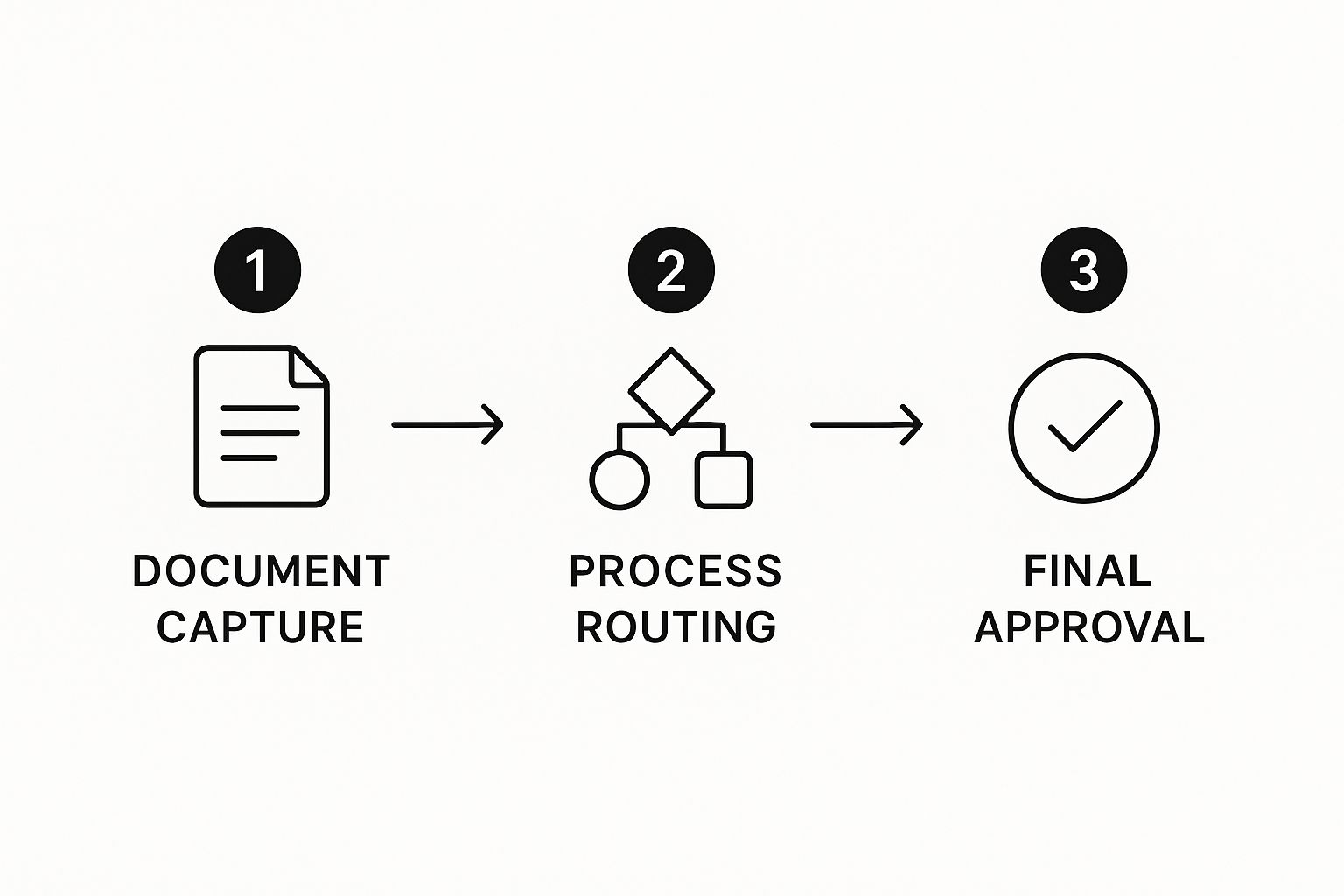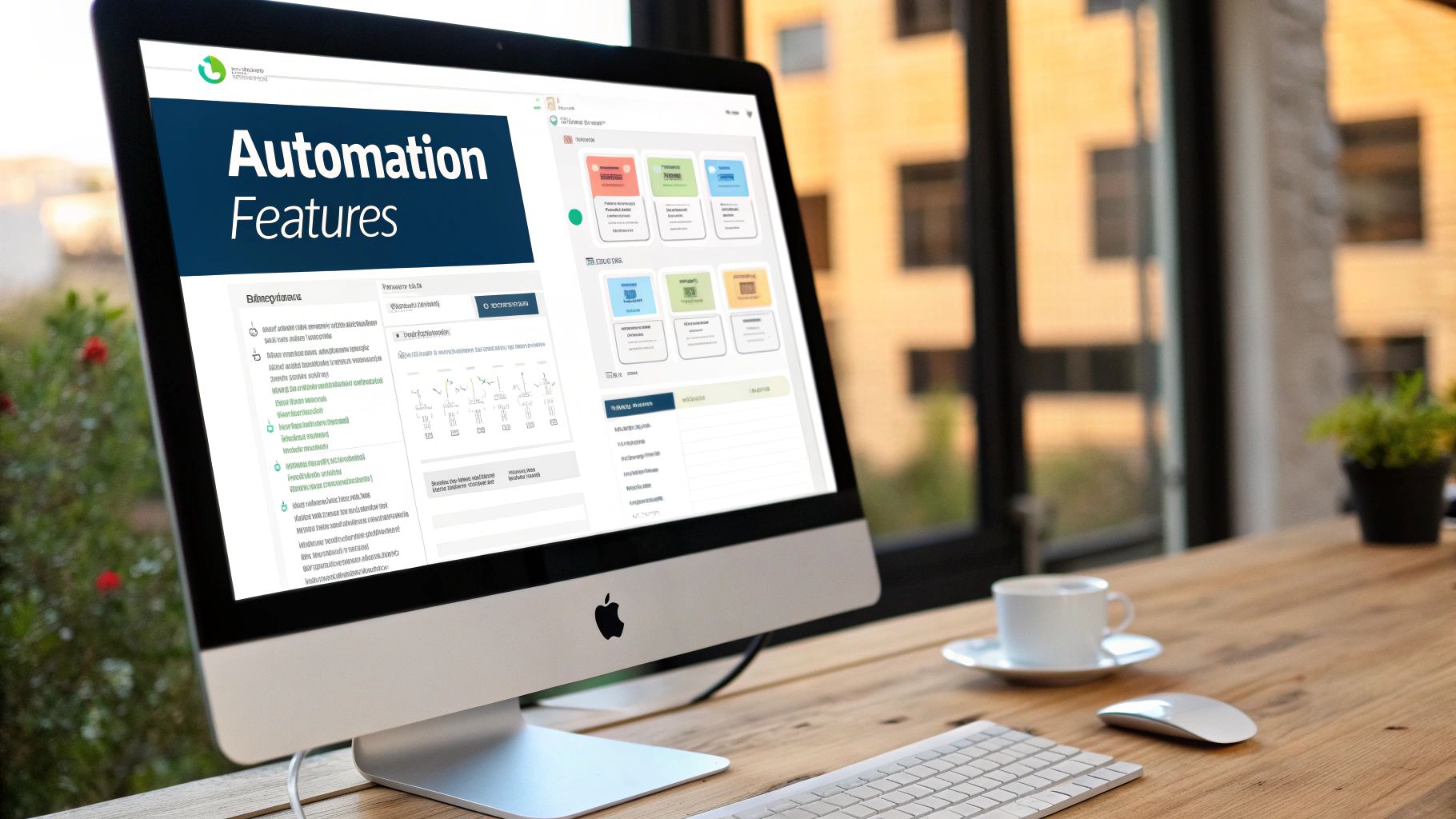Document Workflow Automation Done Right
Let's cut right to it. When we talk about document workflow automation, we're really talking about teaching software to handle all those tedious, repetitive file-based tasks for you. Instead of a person manually sorting invoices or chasing down signatures for a contract, a smart system takes over based on rules you set.
What Is Document Workflow Automation, Really?

Forget the corporate jargon for a second. At its heart, document workflow automation is a practical strategy for getting time back and stamping out human error. It's all about setting up intelligent systems to manage your documents from the moment they're created to when they're archived, all without someone having to babysit the process.
Think about the everyday holdups that grind your business to a halt. A sales contract is just sitting in an inbox, waiting for a signature. A crucial vendor invoice gets buried under a mountain of other emails. A team member burns 20 minutes hunting for the latest version of a project brief. These little hiccups add up, causing major productivity drains and operational headaches. A solid automation strategy is designed to fix exactly that.
Ending the Manual Paper Chase
For too many teams, handling documents is a frustrating, hands-on job. You know the drill: download an attachment, rename the file, drag it into the right shared folder, and then ping the next person in line. Every single one of those steps is a place where things can go wrong.
A file gets misnamed, saved in the wrong spot, or an email is simply missed. This manual shuffle doesn't just eat up time; it creates unnecessary risk. Document workflow automation swaps out that fragile, person-dependent routine for a reliable, repeatable system. If you want to really dig into the mechanics of this shift, you can explore how to Boost Efficiency with Document Workflow Automation.
And this isn't just a game for big corporations. Small teams can gain huge advantages by automating even their simplest, most critical tasks. Some of the biggest wins include:
- Fewer Mistakes: Automating things like data entry and file routing drastically cuts down on the typos and misfiled documents that cost a fortune to correct later.
- Quicker Turnarounds: Contracts get signed faster, invoices get paid on time, and projects keep moving without hitting preventable roadblocks.
- Better Compliance: An automated system guarantees that every document goes through the required steps, which creates a clean and easy-to-follow audit trail.
When you build an automated workflow, you're doing more than just implementing a new tool. You're engineering a more resilient and responsive backbone for your business operations. It’s about making sure the work gets done smoothly, even when your team is swamped.
How to Prepare Your Business for Automation

I've seen it happen time and time again: a business gets excited about automation, buys a new tool, and expects magic. The biggest mistake you can make with document workflow automation is jumping straight to the software. A shiny new app might look like a quick fix, but real success starts with a solid plan.
Think of the technology as just one piece of the puzzle. The real work—the foundational stuff—is digging into your existing processes before you even think about a tool.
So, put on your detective hat. Your mission is to uncover the exact points of friction in your daily operations. You're looking for those manual, repetitive tasks that eat up valuable time and open the door to human error. These are the golden opportunities for automation.
A great way to start is by tracking a single, high-impact document from start to finish. For instance, what happens to a vendor invoice from the moment it lands in your inbox until it’s paid and archived? Sketch out every single step, from downloading the PDF to the final confirmation.
Find Your Biggest Time-Wasters
Once you have that process mapped out, you can start spotting the bottlenecks. Where do documents stall? Which steps are completely manual and make you want to pull your hair out? This analysis is what tells you where automation will give you the biggest bang for your buck.
From my experience, these are some of the most common pain points to look for:
- Manual Data Entry: Is a team member literally just re-typing information from a PDF into another program? This is a textbook case for automation.
- File Naming and Sorting: Does someone spend a chunk of their day renaming files and dragging them into the right folders? That time adds up.
- Chasing Approvals: How many hours are lost sending follow-up emails just to get a contract or proposal signed?
Focusing on these areas also has a domino effect on storage and speed. For example, before you automate how files are moved, you can build in a step to reduce file sizes and save space. This makes the entire workflow leaner and faster.
The tool is only 20% of the solution. The other 80% is the strategic foundation you build first. This groundwork ensures a smooth rollout and a real return on your investment in document workflow automation.
Set Clear Goals and Get Your Team Onboard
Now that you've identified a process to tackle, you need to define what success actually looks like. Vague goals like "improve efficiency" won't cut it. Get specific and set measurable targets. A much better goal would be, "We will reduce invoice processing time from two days to four hours," or "We will eliminate all data entry errors on new client intake forms."
Getting your team and leadership to buy into the plan is equally crucial. Frame it in terms of how it helps them directly—by eliminating boring, repetitive work and freeing them up to focus on more strategic, engaging tasks. The data backs this up. One Kissflow.com analysis of automation trends found that 94% of companies perform repetitive tasks perfect for automation, and that 90% of knowledge workers feel automation has improved their jobs.
When you approach the challenge with a clear, strategic plan, you elevate document workflow automation from a simple tech project into a powerful business advantage.
Alright, let's get our hands dirty and build your first automated workflow. Theory is great, but the real "aha!" moment comes when you see this stuff in action. We'll start with a classic pain point for almost every business: processing vendor invoices.
This is the perfect use case. It's repetitive, manual, and mistakes can be costly. Someone gets an invoice PDF, opens it, hunts for the key details, renames the file (hopefully correctly), and then drags it into a folder. We're about to make that whole tedious dance a thing of the past.
The Core Components of Your First Workflow
Before we jump in, it helps to understand the moving parts. Think of it like a simple recipe. You have your ingredients (the files), your instructions (the rules), and your final dish (the organized, ready-to-use document).
Here's a quick breakdown of the key elements you'll be setting up in Compresto.
| Component | Function | Example Use Case |
|---|---|---|
| Watched Folder | A designated folder on your computer that Compresto constantly monitors for new files. | Creating a folder on your Desktop called "New Invoices" to catch all incoming vendor PDFs. |
| Extraction Rule | A rule that tells Compresto to "read" a document and pull out specific pieces of text or data. | Finding and copying the number that follows the "Invoice #" label inside a PDF. |
| Renaming Rule | Uses extracted data to automatically rename the file according to a consistent, logical format. | Renaming an invoice to 2024-07-15_AcmeCorp_INV-12345.pdf. |
| Filing Rule | A final instruction that moves the processed and renamed file to its permanent home. | Moving the renamed invoice to a shared network drive folder named _Ready for Payment. |
Putting these four pieces together creates a powerful, hands-off system that runs on its own.
Setting Up Your "Digital Inbox"
First things first, you need to give Compresto a place to watch. We call this a watched folder, but you can just think of it as a digital inbox or a hot folder. It's any regular folder on your Mac that will act as the trigger for your entire workflow.
For our invoice example, you could create a folder right on your Desktop and name it Incoming Invoices. That’s it.
From now on, instead of letting invoices pile up in an email inbox, you just save the attachments directly to this folder. Compresto immediately knows a new task has arrived. This one small change establishes a single source of truth for all incoming bills.

This process might sound complex, but it really boils down to three simple phases: capture the file, process it with your rules, and deliver it to its final destination.
Teaching Compresto What to Do
This is where you add the smarts to the system. You’re going to lay out a simple, logical sequence of rules for Compresto to follow every time a new PDF lands in your Incoming Invoices folder. No coding required.
Here’s a practical recipe for our invoice scenario:
- Tell it what to find: First, create an extraction rule. We'll tell Compresto to look for the text that comes directly after the label "Invoice #." It will grab that number and hold onto it.
- Create a clean file name: Next, set up a renaming rule. We'll use the invoice number we just extracted to build a new, super-organized file name. Something like
YYYY-MM-DD_[VendorName]_[InvoiceNumber].pdfworks wonders for sorting and searching later. - Put the file in its place: Finally, add a filing rule. This rule tells Compresto to move the freshly renamed file into a different folder—maybe a shared drive folder called
Invoices_Ready_for_Paymentwhere your finance team can see it.
Key Takeaway: The goal isn't just to move a file from point A to point B. It's about enriching the file along the way. By pulling out key data and using it to rename and sort the document, you make that information immediately useful and accessible to everyone who needs it.
With your watched folder and rules in place, your automation is officially live. The next time you get an invoice, just save the PDF into your Incoming Invoices folder.
In a matter of seconds, Compresto sees it, reads it, renames it, and files it away perfectly. No typos, no forgotten attachments, no "I'll get to it later." You’ve just built a reliable, repeatable process—your first step toward solving much bigger document headaches.
Exploring Advanced Automation Techniques

So, you’ve built a basic file-and-sort workflow. You're already feeling the power of taking manual tasks off your plate. But that’s just scratching the surface. The real magic begins when you start layering rules and connecting different processes to build truly intelligent workflows that fit your business like a glove.
This is where you graduate from simple A-to-B filing and start creating systems that think. Imagine a workflow that doesn't just process incoming invoices but routes them based on their value. A contract under $5,000? It zips straight to the team lead for approval. But one over $50,000? That gets automatically sent to the legal department’s high-priority folder, no questions asked.
This kind of conditional logic turns your automation from a simple filing clerk into a smart assistant that makes decisions for you.
Chaining Processes for Sophisticated Data Handling
The secret to building these smarter workflows is chaining. It’s all about linking individual processes together so they trigger each other in a domino effect. One action kicks off another, then another, creating a powerful sequence that handles complex jobs without you lifting a finger.
A great real-world example is dealing with the huge media files from a video shoot. A basic workflow might just move them into a folder. A chained workflow, on the other hand, is a production powerhouse.
- Initial Drop: The videographer finishes a shoot and drops a massive 4K video file into a monitored folder called
_New Footage. - Compression Chain: Compresto instantly detects the new file and its first move is to compress it, shrinking it down for easier storage and sharing. We talk a lot more about this in our guide to managing large files with ease.
- Conversion Chain: Right after compression, a second rule kicks in. This one automatically creates a low-resolution proxy version or a quick GIF for fast previews in your team's chat app.
- Filing Chain: Finally, the original compressed file and its new proxy are renamed with the project code and date, then neatly filed away into
_Final Rendersand_Proxiesfolders.
This multi-step automation turns a tedious, time-consuming task into a background process that’s over in seconds. Every file is optimized, organized, and exactly where it needs to be.
Connecting to Your Other Tools with Webhooks
Let's be honest: a truly automated workflow can't live on an island. Your document processes are almost always tied to other business tools—your project management software, your team's communication platform, or your cloud storage. This is where webhooks become your best friend.
Think of a webhook as a simple notification that one app sends to another when something happens. In a Compresto workflow, you can set up a webhook to fire off after a document is processed. For instance, once a critical client contract is signed and filed, a webhook can instantly post a message to a specific Slack channel to let the sales team know the deal is done.
This connectivity is the linchpin of a truly integrated system. It ensures that when a document task is complete, the right people are notified in the tools they already use, keeping projects moving forward without delay.
This level of integration isn't just a nice-to-have anymore; it's becoming a necessity. Businesses are clamoring for ways to manage complex workflows that cut across different departments and systems. This is fueling major investments in automation, with industries like banking and healthcare racing to digitize their old paper-based processes. In fact, a recent IDC analysis of the workflow market highlights just how critical this trend is for modern business operations.
By combining chained rules with webhooks, you’re not just managing files anymore. You’re building a robust, end-to-end system that communicates with your entire tech stack.
Measuring Your Automation Success
Setting up an automated workflow is one thing, but proving it’s making a real difference is another. You can't just rely on a gut feeling that things are running better. To justify the investment and show your team the true impact, you need to measure what matters. This is how you turn a cool tech project into a business strategy with a clear, undeniable return.
Before you even launch your new automated system, take a snapshot of your current reality. This is your baseline. Time how long the manual process takes from start to finish. Count the number of mistakes that pop up each week. What are the hard costs—like employee hours—tied to that work? This starting point becomes the yardstick against which you'll measure every success.
What to Look For: The Key Metrics
To get a crystal-clear picture of your ROI, you don't need a hundred different data points. Focus on a few core key performance indicators (KPIs) that tell a powerful story. These are the numbers that will get leadership's attention and prove the value of your efforts.
Here are the metrics I always recommend my clients track:
-
Processing Time Shrinkage: How long does it take for a document to move through the entire workflow? If manually processing a partner agreement took three days of back-and-forth and now it's done in 20 minutes, that's a huge win you can take to the bank.
-
Error Rate Nosedive: Keep a close eye on human errors—think data entry typos, misfiled reports, or sending the wrong version. Automation is incredibly good at eliminating these. Aiming for a 95% or higher reduction in manual mistakes isn't just optimistic; it's a realistic goal for a well-designed workflow.
-
Hard Cost Savings: This one is straightforward. Calculate the cost of the hours your team was spending on the old, manual task. If you save an employee who earns $30 per hour just 10 hours a week, that’s $300 back in your budget every single week. Annually, that’s $15,600 from a single automated process.
The most compelling case for automation isn't just about speed. It's about what you do with the time you get back. When you can show that automation frees up your team to focus on strategic, creative, or customer-facing work, the investment truly sells itself.
Where This is All Headed: Intelligent Automation
And this is just the beginning. The next wave of automation is already here, and it's powered by AI and machine learning. We're moving beyond simple "if-this-then-that" rules. The new systems can understand the context and intent behind a document.
Imagine a system that can automatically detect the frustrated tone in a customer complaint and escalate it, or recognize the urgency in a legal notice without being explicitly told to. That's the power of intelligent automation.
This shift is what’s fueling massive industry growth. The workflow automation market is on a trajectory to expand from an estimated USD 23.77 billion in 2025 to USD 37.45 billion by 2030. You can read more about these workflow automation market trends to see the full picture.
By getting a handle on your metrics today, you're not just proving the value of your current setup. You're building the foundation to embrace these smarter, more predictive technologies as they become the new standard.
Got Questions About Document Automation? We've Got Answers.
As you start digging into workflow automation, it’s only natural for some practical questions to pop up. Making the switch from old-school manual processes to a slick, automated system can feel like a big leap, but I’ve found it’s usually more straightforward than people expect. Let's tackle some of the things that might be on your mind.
One of the first things people ask me about is security. I get it. Letting an automated tool handle sensitive files can feel a bit unnerving at first. But modern automation platforms are built with security as a top priority. Look for features like end-to-end encryption and tight access controls, which ensure your documents stay protected during processing and in storage. Your data is always yours, and only the people you authorize can ever see it.
Another big question is about file types. A lot of teams assume automation is just for standard PDFs. But what about all the other files you’re juggling every day? A truly useful system can handle just about anything you throw at it—images, presentations, video files, spreadsheets, you name it. The real goal is to build a single, unified workflow so you aren’t stuck processing certain files by hand.
Dodging Common Setup Pitfalls
When you're excited to dive in, it’s easy to make a few common mistakes. The biggest one I see is trying to "boil the ocean"—that is, attempting to build a massive, all-encompassing workflow from day one.
My advice has always been the same: start small. Pick a single, high-impact task that’s relatively simple. Think about renaming those bank statements you download every month. Automate that first. It gives you a quick, satisfying win and builds your confidence to tackle more complex things down the road.
A simple, solid workflow that saves you 15 minutes a day is way more valuable than a super-ambitious one that you never quite finish. Get the basics working, then build on your success.
Finally, there’s the skill question. Do you need a computer science degree to pull this off? Absolutely not. The best tools today are designed for everyone, not just developers. With a clean interface, you can set up powerful rules using simple drop-down menus and plain English. The barrier to entry for effective document workflow automation is lower than it's ever been.
If you have more specific questions, you can always explore our detailed FAQs.
Ready to put the manual busywork behind you and build your first automated workflow? Compresto makes it easy to set up powerful automations on your Mac in just minutes. Start saving time and eliminating errors today by visiting https://compresto.app.